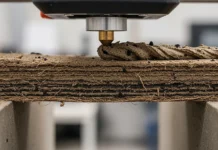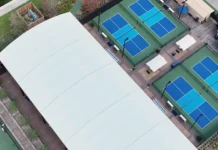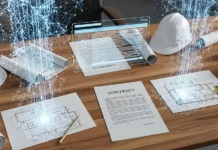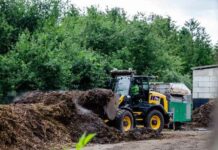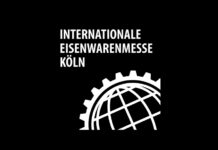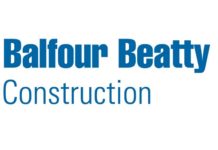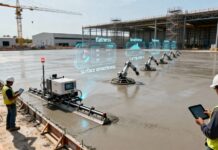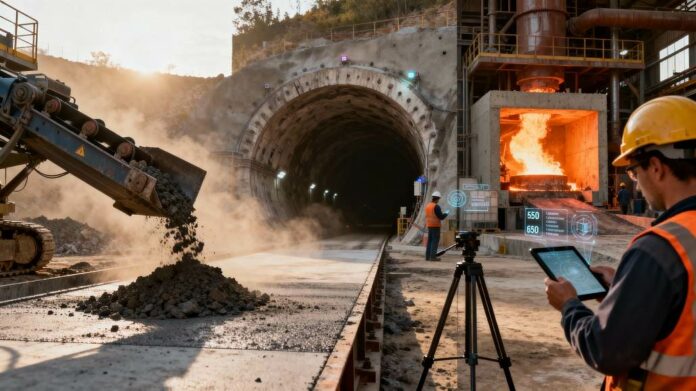Infrastructure and industrial facilities operating in extreme environments confront material challenges that conventional concrete struggles to overcome. Mining operations expose concrete to continuous abrasive particle impact, chemical attacks from ore processing byproducts, and moisture conditions promoting rapid deterioration. Tunnels demand concrete withstanding sustained water pressure, chemical exposure from groundwater, and thermal cycling stresses. Refinery and processing facilities subject concrete to high temperatures, aggressive chemical environments, and mechanical stresses from heavy equipment operation. Traditional concrete, despite centuries of service in conventional applications, demonstrates vulnerability to these combined stresses, failing prematurely and requiring costly remediation or replacement. Ultra-durable concrete formulations, incorporating advanced additives, specialized fiber reinforcement, high-performance binders, and innovative mixture designs, address these demanding requirements while extending structure service lives and reducing lifecycle costs in challenging environments.
Specialized Concrete Formulations for Extreme Thermal Conditions
Advanced thermal environments including furnaces, reactors, and high-temperature processing facilities demand concrete withstanding temperature excursions exceeding 600 degrees Celsius, far beyond conventional concrete capacity. Thermal degradation mechanisms including calcium hydroxide decomposition, C-S-H gel dehydration, and aggregate expansion create structural integrity threats through spalling, strength loss, and cracking that compromise functionality. Ceramic-based ultra-durable concrete formulations incorporate refractory components including silicon carbide, alumina, zirconium, and specialized ceramic fibers that maintain integrity under extreme thermal stresses where conventional concrete fails catastrophically.
Ceramic fiber reinforcement replaces traditional steel reinforcement in some ultra-durable applications, offering advantages particularly valuable in extreme thermal environments. Steel, while providing excellent mechanical reinforcement, expands and contracts substantially with temperature cycling, creating additional stresses and promoting cracking. Ceramic fibers with thermal expansion characteristics more closely matched to concrete matrices, combined with their inherent heat resistance, provide reinforcement benefits without the thermal incompatibility liabilities of steel. Three-dimensional fiber distribution throughout concrete volumes provides tensile strength and crack control in all directions, preventing brittle failure modes characteristic of unreinforced or inadequately reinforced materials.
High-temperature-resistant concrete formulations employ specialized binder systems designed to maintain strength and durability under sustained elevated temperature exposure. Traditional Portland cement hydrates decompose significantly at temperatures exceeding 300 degrees Celsius, losing structural contribution through loss of chemically bound water and transformation of hydration products. Geopolymer binders demonstrate superior thermal stability, maintaining strength and integrity through temperature variations that compromise Portland cement systems. Calcium aluminate cements offer advantages in high-temperature applications through different hydration reactions producing phases more thermally stable than Portland cement products.
Aggregate selection becomes critical in extreme thermal applications. Natural stone aggregates commonly used in conventional concrete expand differentially with temperature changes and may undergo phase transformations at elevated temperatures, creating internal stresses and spalling risks. Ultra-durable formulations employ refractory aggregates including chamotte, fireclay, or expanded clay specifically selected for thermal stability and compatibility with binder systems. Aggregate grading carefully controls porosity and pore size distribution, optimizing thermal conductivity and minimizing stress concentration points where damage initiates.
Abrasion and Wear Resistance in Heavy-Duty Industrial Applications
Mining and material handling environments expose concrete surfaces to continuous abrasive impact from tumbling ore, dragging loads, and equipment traffic creating wear rates that reduce structural dimensions over relatively brief periods. Conventional concrete typically degrades at rates creating maintenance requirements every few years in severely abraded applications. Ultra-durable concrete formulations incorporating specialized aggregates, fiber reinforcement, and surface hardening treatments achieve wear resistance extending service life to decades, dramatically improving project economics despite initial material cost premiums.
Steel fiber reinforced concrete delivers superior wear and abrasion performance compared to unreinforced alternatives by multiple mechanisms. The fibers distributed throughout concrete matrices arrest crack propagation that initiates spalling and abrasion damage. Surface fibers protruding through concrete surfaces improve mechanical resistance to dragging and sliding loads. Load carrying capacity of fiber-reinforced materials reduces compressive stresses in aggregate particles during impact events, decreasing particle fracture and aggregate loss. The combination of these mechanisms extends abrasion resistance, reducing surface deterioration rates and preserving structural dimensions throughout intended service lives.
High-wear surface treatments including epoxy and polyurethane coatings overlay ultra-durable concrete substrates, providing additional abrasion protection where direct protection of concrete proves necessary. These coatings create durable, easily-cleanable surfaces resistant to chemical attack and moisture penetration. The underlying ultra-durable concrete substrate provides structural integrity and protection if surface coatings experience localized damage. Combined systems offer comprehensive protection throughout intended service lives, eliminating or dramatically reducing maintenance requirements during occupancy.
Aggregate selection significantly influences abrasion resistance through both mechanical hardness and bonding characteristics. Dolomitic aggregates and specialized crushed stone selected for hardness values minimizing particle fracture provide superior durability compared to softer natural aggregates. Angular aggregate particles interlock more effectively than rounded alternatives, improving mechanical bonding and load transfer. Careful quality control during aggregate selection and concrete production ensures consistent properties across batches, eliminating variability that compromises durability in critical applications.
Chemical Resistance and Corrosion Protection in Aggressive Environments
Industrial facilities processing chemicals, treating wastewater, or handling acidic or alkaline materials subject concrete to chemical attacks that rapidly degrade conventional formulations. Sulfuric acid exposure, whether from industrial processing or biogenic sources in treatment systems, attacks Portland cement hydration products and promotes expansion cracking. Chloride penetration in marine or de-icing salt environments triggers reinforcement corrosion, eventually compromising structural integrity through expansion and spalling. Alkali-aggregate reactions, where certain aggregates react with alkaline pore solutions, create expansion stresses causing cracking and strength loss.
Ultra-durable concrete formulations employ specialized binders demonstrating superior chemical resistance compared to conventional Portland cement. Geopolymer systems exhibit remarkable resistance to sulfuric acid attacks that rapidly compromise Portland cement materials. The three-dimensional inorganic polymer network characteristic of geopolymers provides dense microstructures with reduced permeability limiting chemical ingress. Chemical resistance testing confirms geopolymer concrete maintains structural integrity under sulfuric acid exposures that would destroy conventional materials in similar timeframes.
Low-permeability concrete reduces chemical ingress through denser microstructures limiting capillary pathways and pore connectivity that transport aggressive species into concrete depths. Mixture design optimization incorporating supplementary cementitious materials including silica fume or fly ash produces microstructures with smaller average pore sizes and reduced permeability. Water-cement ratios maintained at minimum levels consistent with workability requirements reduce capillary porosity in hardened concrete. Combined approaches reduce chemical diffusion rates, extending time to corrosion initiation and extending structural service lives in aggressive chemical environments.
Protective coatings provide additional chemical resistance layers for particularly aggressive applications. Organic coatings including epoxies and polyurethanes create barriers limiting chemical contact with underlying concrete. Inorganic coatings including ceramic-based products withstand temperature variations and mechanical abrasion better than organic alternatives in extremely harsh environments. Penetrating sealers fill surface pores without creating distinct barrier layers, maintaining concrete breathability while reducing water absorption and chemical ingress. Coating selection depends on specific chemicals present, temperature conditions, and mechanical stresses anticipated during service.
Tunnel Lining Concrete and Specialized Underground Applications
Tunnels represent particularly demanding applications requiring concrete simultaneously withstanding water pressure, earth loads, thermal cycling, and maintenance access requirements over extended service lives often specified at 100 years or longer. Steel fiber reinforced concrete has emerged as particularly effective for tunnel applications, replacing traditional reinforcement methods in many projects. The fibers provide tensile strength and crack control benefits critical in tunnel linings where cracking can permit water infiltration and eventual structural deterioration. Benefits include reduced reinforcement installation complexity, improved constructability for sprayed concrete applications, and enhanced safety during production and handling phases.
Sprayed concrete for tunnel linings employs ultra-durable formulations optimized for adhesion to rock faces and development of early strength supporting rapid excavation progression. Early strength achievement enables quick progression through tunnel sections, accelerating project schedules and improving contractor economics. Steel fiber reinforcement allows fast application in single-step spraying operations, eliminating complex multi-phase reinforcement installation. The resulting concrete achieves adequate structural performance while supporting aggressive project schedules.
Precast concrete tunnel lining segments, manufactured under controlled factory conditions, offer advantages including consistent quality, optimized reinforcement placement, and minimal quality variability. Ultra-durable concrete formulations ensure long-term performance despite concrete potentially experiencing decades or centuries of service. Quality control during manufacturing verifies mechanical properties, durability characteristics, and dimensional compliance, ensuring segments meet specifications and perform reliably throughout intended service life. The combination of quality assurance during manufacturing with ultra-durable concrete formulations provides confidence in long-term tunnel integrity.
Water management represents a critical consideration in underground applications where moisture infiltration can initiate concrete degradation and create operational problems. Hydrophobic additives incorporated into concrete formulations reduce water absorption and capillary moisture transport. Combined with low-permeability matrices achieved through dense microstructure development, these measures substantially reduce moisture ingress. Drainage systems behind tunnel linings direct groundwater away from concrete surfaces, preventing sustained saturation that accelerates deterioration. Integrated moisture management combining material properties with drainage design optimizes tunnel durability over extended service lives.
Performance Verification and Durability Assessment
Evaluating ultra-durable concrete performance requires comprehensive testing protocols verifying behavior under anticipated extreme conditions. Standard concrete tests developed for conventional applications often prove inadequate for assessing performance in specialized environments. Extended durability testing subjecting samples to simulated thermal cycling, chemical exposure, or abrasion conditions provides confidence in real-world performance. Accelerated testing procedures compress timeframes, providing results within project development timelines rather than requiring decades of field exposure data collection.
Long-term field performance data from pioneering ultra-durable concrete projects increasingly validates laboratory predictions and informs future formulation optimization. Tunnels, industrial facilities, and infrastructure projects incorporating advanced concrete formulations provide valuable performance documentation. Periodic inspections and condition monitoring generate real-world data about degradation rates, damage mechanisms, and overall durability outcomes. This field experience accelerates technology acceptance and informs design optimization for future projects.
Specification development for ultra-durable concrete applications requires clear definition of performance requirements and verification methods. Rather than specifying prescriptive concrete component proportions applicable primarily to conventional applications, performance-based specifications define measurable performance criteria and appropriate verification methods. Compressive strength, permeability, thermal stability, and chemical resistance can all be specified quantitatively with appropriate testing methods determining compliance. Performance-based approaches encourage innovation while maintaining assurance of adequate material behavior.
Future Developments and Technology Evolution
Advancing ultra-durable concrete technology continues through research investigations refining materials, additives, and mixture designs. Development of nano-engineered concrete incorporates particles at molecular scales improving concrete microstructure and enhancing performance. Carbon fiber reinforcement offers advantages over steel or ceramic alternatives including superior strength-to-weight ratios and excellent corrosion resistance, though cost constraints currently limit applications. Self-healing concrete incorporating capsules of repair compounds or biological organisms promises extended service lives through autonomous damage repair.
Integration of embedded sensors monitoring concrete condition throughout service life enables predictive maintenance strategies optimizing repair timing and extending asset value. Real-time data about temperature, moisture, strain, and chemical exposure informs facility managers about concrete condition and remaining service life. Predictive models fed with sensor data and historical performance information support informed decisions about maintenance, repair, or replacement timing. This data-driven approach maximizes infrastructure value through optimal timing of interventions.
Sustainability considerations increasingly influence ultra-durable concrete development alongside performance objectives. Formulations incorporating recycled materials or waste byproducts as partial binder or aggregate replacement reduce environmental impact while maintaining performance. Extended service life reduces replacement frequency and associated environmental costs throughout infrastructure lifecycles. Optimization of embodied carbon while maintaining required durability characteristics represents a critical development area aligning performance objectives with environmental imperatives.
Ultra-durable concrete formulations exemplify how targeted innovation addresses critical challenges in infrastructure serving extreme environments. These materials enable extended service lives and reduced maintenance requirements justifying initial cost premiums through lifecycle value delivery. As technology matures and manufacturing scales expand, improved performance becomes increasingly accessible for challenging applications where conventional concrete proves inadequate. The continuing evolution of ultra-durable concrete supports reliable infrastructure operation in the most demanding environments while advancing broader construction industry sustainability objectives.



